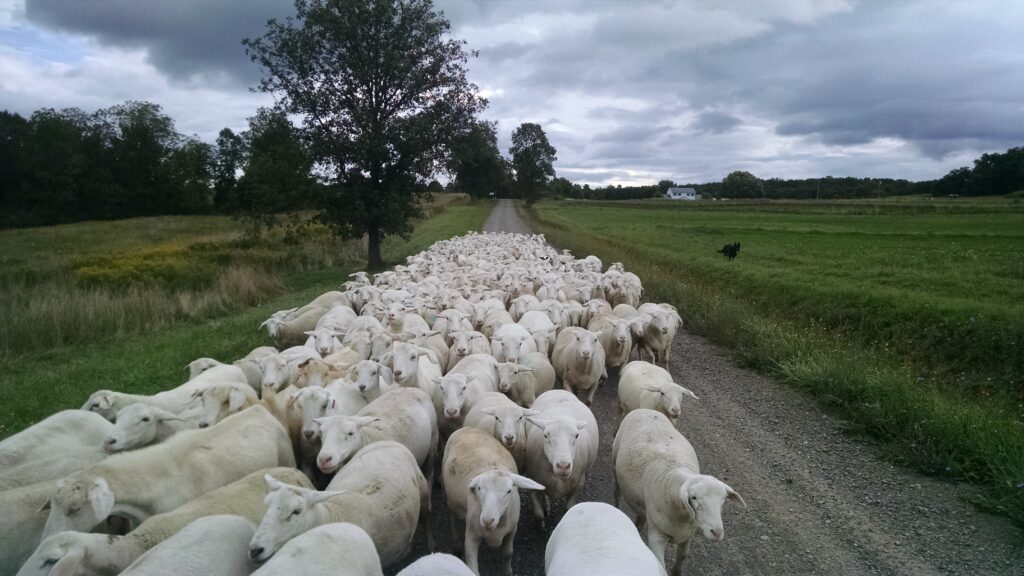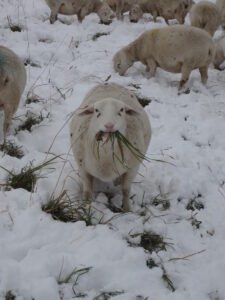Extending The Grazing Season Beyond Growing Season
How To Do It And To What End
Extending the grazing season well beyond the end of growing season is a desirable goal when raising sheep on pasture. Feeding stored feed like dry hay and haylage over the winter is costly. Extending the grazing season can reduce these winter-feeding costs.
There are various ways to extend the grazing season into late fall and early winter. One method is to “stockpile” existing perennial pasture. It simply means to let pasture grow, starting in late summer or early fall, and save it for grazing later in late fall or early winter. You would allow the pasture to grow for approximately 50 to 60 days before the end of growing season. Longer than the 60-day period is not advisable. The gain in growth will be minimal, if any. The quality and digestibility of the forage will decrease with every additional day. To be able to stockpile, you would need to have additional acreage available beyond the grazing acreage that you need for your existing flock. If you are also making all your winter feed on your land, you are likely to have this additional acreage.

Moving the flock with the use of a herding dog to harvested hay fields at a neighboring farm. (Ulf Kintzel/ White Clover Sheep Farm)
Stockpiled forage holds its value well into the winter. The quality is comparable or better than hay that could have been made on these acres instead during the time of stockpiling. However, grazing the land is far less costly than making and then feeding the hay.
If you already own agricultural machinery and farm in other ways besides raising sheep, a practical way of extending grazing season is to plant forage after harvest of small grains in late summer or early fall. (I do not recommend plowing up perennial pasture for this purpose unless the pasture needs rejuvenation anyway). This forage will function as a cover crop as well as forage for grazing. Remember, the most valuable part of the cover crop is its roots. That means grazing it will subtract very little from its purpose. Depending on when you can plant winter forage after harvest, there are several options. Triticale is a valuable choice since it will likely yield high, is very winter hardy, will hold its feed value throughout the winter, and can even be harvested the next spring as baleage. Oats is another high-yielding option and is well liked by sheep, even after it heads out. Oats have the added benefit that the winter frosts will kill it and it will not cause a problem in the crop planted the following spring. If you are a little late in the season and need a cover crop that germinates and grows under much cooler weather, consider cereal rye. It is a high-energy winter feed like triticale but is much hardier and will grow on marginal soils as well. It develops allelopathic compounds, which suppress the germination of weed seeds but also can affect crops with small seeds planted the following spring. Crops with larger seeds are rarely affected by it.
There are other winter crops that are being recommended in seed catalogues, alone or as mixtures. Turnips are high on the list of desirable winter feed. Brassicas like rape seed, oilseed radish (daikon) are other viable options. All of these can be mixed with annual ryegrass, triticale, or oats.

These sheep are grazing on stockpiled pasture in December. The light snow cover helps preserving the quality of the forage. (Ulf Kintzel/White Clover Sheep Farm)
I have been extending my grazing season by stockpiling but also by grazing neighboring harvested hay fields in the fall and early winter, using my herding dogs to get there and electric nettings, electrified by battery-powered energizers to graze these fields. That allows me every year to delay the onset of feeding stored forage (in my case dry hay) until early to perhaps mid-January. Heavy snow in early January might put an end to grazing even when I haven’t entirely run out of grazing opportunities. That means my grazing season usually lasts about nine months. I feed hay for only three months of the year, about one round bale per ewe during that time. That amounts to no more than $40 to $50 hay feeding cost per ewe all winter.
What about extending the grazing season even further? Heavy snowfall and cold temperatures, paired with windy conditions, are the norm for me in Western New York during the months of January and February. I suspect the same holds true for most of the readers of this publication, living in the Northeast and in New England. These adverse conditions make it hard on both the sheep, who would have to dig through heavy, perhaps even drifted snow, using up much of the energy they might gain once they get to the forage. Windy conditions paired with cold weather may make it altogether impossible to graze. Setting up and moving portable fencing will also be a challenge in heavy snow or frozen soils. During the month of March, the thawing soil often loses its structure. Mud is the result, possibly causing harm to the sod with the animal traffic and making it hard or impossible to drive into the pasture. In short, extending the grazing season even further may not be desirable since it takes a toll on both the animals and the humans tending to them. It may defeat the purpose of grazing by making it unsustainable in the long run, especially with ageing (like me) or older farm managers, who do not wish to expose themselves to the extremes with possibly marginal financial savings.
The calculation may be different if you raise sheep further south, in states like Virginia, Maryland, or Missouri. There, extending grazing season to up to 12 months and only having hay for emergency purposes for the times of infrequent winter storms or adverse weather, is entirely possible. Some of these states are known for their tall fescue as their dominant pasture species. Sheep do not like tall fescue much. However, that changes when the days get colder and nighttime temperatures get down to freezing or near freezing. That is when fescue puts sugars from the roots back into the plants and are now sought out and well-liked by sheep. In addition, among all cool season grass species, tall fescue holds its feed value the best into late winter, far surpassing any other cool season grass species. That feed value is likely in February still comparable or better than any dry hay. In addition, fescue sods are seemingly indestructible and can take a lot of “abuse” during times when other pastures might get harmed by animal traffic and vehicles.
Ultimately, the decision how to extend the grazing season and for how long will be different in every case because everyone’s circumstances will be unique and different from each other. There isn’t a one-size-fits-all approach. While extending the grazing season is or should be a desirable economical goal, going the extreme mile may not be worth it because of the toll on both humans and animals. Instead, I recommend finding your personal sweet spot.

